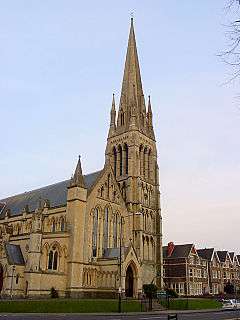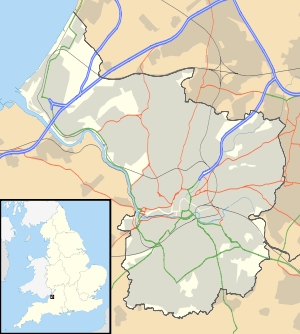Christ Church, Clifton Down
Christ Church (grid reference ST571739) is a Church of England parish church in Clifton, Bristol, England. It has been designated as a Grade II* listed building.[1][2]
| Christ Church | |
|---|---|
 | |
 Location within Bristol | |
| General information | |
| Town or city | Bristol |
| Country | England |
| Coordinates | 51.462891°N 2.618196°W |
| Completed | 1841 |
| Design and construction | |
| Architect | Charles Dyer |
History
The church was built in 1841 by Charles Dyer. The steeple was built in 1859 by John Norton, and the aisles in 1885 by William Basset Smith.[3][2]
In 2015 the church was closed for two weeks after the steeple was damaged in high winds.[4]
The Anglican parish is part of the benefice of Christ Church with Emmanuel, Clifton which falls within the Diocese of Bristol. It is affiliated with the New Wine Network.[5]
Architecture
The cruciform limestone building has a slate roof. It was built in the Early English Gothic Revival style. There is an octagonal apse. The north transept is supported by buttresses.[2]
The steeple above the five-stage tower reaches 65 metres (213 ft). At its base is a doorway with Purbeck marble shafts.[2] Inside the church is a west gallery supported by cast iron columns with timber cladding.[6]
A replica of the church exists in Thames Town, a suburb of Shanghai built in a style imitative of English architecture.[7][8]
Archives
Parish records for Christ Church, Clifton, Bristol are held at Bristol Archives (Ref. P.CC) (online catalogue) including baptism and marriage registers. The archive also includes records of the incumbent, churchwardens, parochial church council, charities and vestry.
See also
| Wikimedia Commons has media related to Christ Church, Clifton. |
References
- Historic England. "Christ Church (1202095)". National Heritage List for England. Retrieved 16 March 2007.
- Historic England. "Christ Church (1202095)". National Heritage List for England. Retrieved 23 October 2016.
- "Christ Church Clifton". Emporis Buildings. Retrieved 15 May 2007.
- "Christ Church damaged spire in Bristol assessed for repairs". BBC. Retrieved 23 October 2016.
- "Christ Church, Clifton". A Church Near You. Church of England. Retrieved 23 October 2016.
- Foyle, Andrew (2004). Bristol (Pevsner Architectural Guides: City Guides). Yale University Press. pp. 224–225. ISBN 978-0300104424.
- Lim, Louisa (12 December 2006). "China Gets Its Own Slice of English Countryside". World News. NPR. Retrieved 11 April 2012.
- "Why We Shouldn't Mock the Idea of an Eiffel Tower in Hangzhou". CityLab. Retrieved 11 February 2017.
External links
- Christ Church
- Christ Church, Clifton, on ChurchCrawler
- Gnu Tube: The Singers and Musicians of Christ Church Clifton